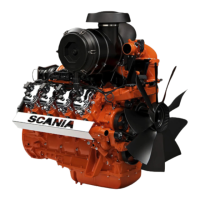INSTALLATION
MANUAL
© Scania CV AB 2018, Sweden
Electrical cables
03:01 Issue 11 en-GB 10
Electrical cables
Routing cables
When engines are supplied without instrumentation, all cables from the engine, ex-
cept for the starter and alternator cables, should be collected together on a junction
block or in a junction box and then continued with an extension cable to the instru-
ment panel or central electric unit.
Do not place the junction box or junction block directly on the engine as this will ex-
pose it to harmful vibrations. Protect it from water, oil, heat and mechanical damage.
Ideally, route the cables along the bottom part of the engine where there is least
movement.
When routing electrical cables, there must be no risk of chafing. Use chafing covers
if there is such a risk. The cables must not touch any sharp edges, radius < 0.5 mm,
e.g. sharp edges or ends of threaded screws.
When the cables are clamped to rubber hoses, the cable must not interfere with the
movement of the hose.
The cables must be long enough so that they are not stretched.
The distance between the cable clamps, e.g. cable ties, should be 350-400 mm.
The cables must be routed as far away from hot areas, > 70°C, as possible. The fol-
lowing minimum distance applies if there is no heat shield:
• Exhaust pipe upstream of silencer, front part of silencer – 100 mm.
• Exhaust pipe downstream of silencer, rear part of silencer – 60 mm.
• Exhaust pipe, engine and cab heater – 40 mm.
• Coolant pipe, engine – 60 mm.
A conventional cable harness and CAN cable harness can be routed side by side with-
out interference.

